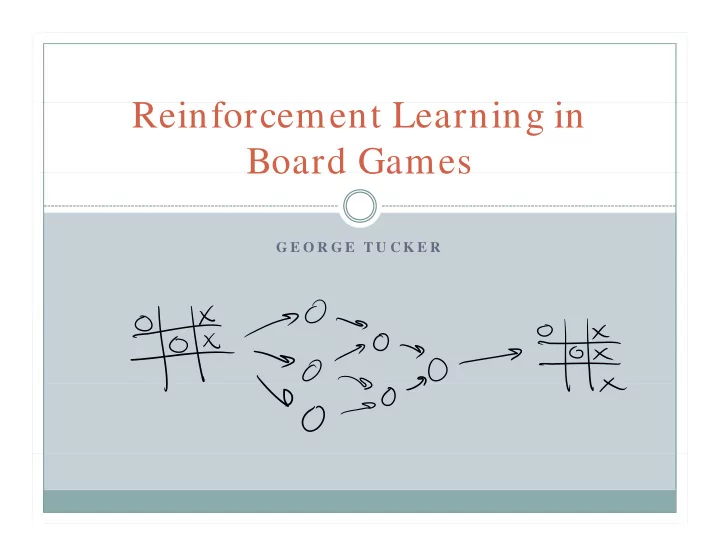

R i f Reinforcement Learning in L i i Board Games Board Games G E O R G E T U C K E R G E O R G E T U C K E R
Paper Background � Reinforcement learning in board games g g � Imran Ghory � 2004 � Surveys progress in last decade � Suggests improvements � Formalizes key game properties � Develops a TD-learning game system
Why board games? � Regarded as a sign of intelligence and learning g g g g � Chess � Games as simplified models � Battleship � Existing methods of comparison � Rating systems i
What is reinforcement learning? � After a sequence of actions get a reward q g � Positive or negative � Temporal credit assignment problem � Determine credit for the reward � Temporal Difference Methods � TD-lambda � TD-lambda
History � Basics developed by Arthur Samuel p y � Checkers � Richard Sutton introduced TD-lambda � Gerald Tesauro creates TD-Gammon � Chess and Go � Worse then conventional AI
History � Othello � Contradictory results � Substantial growth since then � TD-lambda has potential to learn game variants
Conventional Strategies � Most methods use an evaluation function � Use minimax/ alpha-beta search � Hand-designed feature detectors g � Evaluation function is a weighted sum � So why TD learning? � Does not need hand coded features � Generalization li i
Temporal Difference Learning
Temporal Difference Learning
Disadvantage � Requires lots of training q g � Self-play � Short-term pathologies � Randomization
TD Algorithm Variants � TD-Leaf � Evaluation function search � TD-Directed � Minimax search � TD-Mu � Fixed opponent i d � Use evaluation function on opponent’s moves
Current State � Many improvements y p � Sparse and dubious validation � Hard to check � Tuning weights � Nonlinear combinations � Differentiate between effective and ineffective � Differentiate between effective and ineffective � Automated evolution method of feature generation � Turian � Turian
Important Game Properties � Board Smoothness � Capabilities tied to smoothness � Based on the board representation � Divergence rate � Divergence rate � Measure how a single move changes the board � Backgammon and Chess – low to medium � Othello – high � Forced exploration � State space complexity St t s l it � Longer training � Possibly the most important factor y p
Importance of State space complexity
Training Data � Random play � Limited use � Fixed opponent � Game environment and opponent are one � Game environment and opponent are one � Database play � Speed p � Self-play � No outside sources for data � Slow Sl � Learns what works � Hybrid methods Hybrid methods
Improvement: General � Reward size � Fixed value � Based on end board � Board encoding � Board encoding � When to learn? � Every move? y � Random moves? � Repetitive learning � Board inversion d � Batch learning
Improvement: Neural Network � Functions in Neural Network � Radial Basis Functions � Training algorithm � RPROP � Random weight initialization � Significance Si ifi
Improvement: Self-play � Asymmetry y y � Game-tree + function approximator � Player handling � Tesauro adds an extra unit � Negate score (zero-sum game) � Reverse colors � Reverse colors � Random moves � Algorithm � Algorithm � Informed final board evaluation
Evaluation � Tic-tac-toe and Connect 4 � Amenable to TD-learning � Human board encoding is near optimal � Networks across multiple games � A general game player � Plays perfectly near end game � Plays perfectly near end game � Randomly otherwise � Random-decay handicap � % of moves are random � Common system
Random Initializations � Significant impact on learning g p g
Inverted Board � Speeds up initial training p p g
Random Move Selection � More sophisticated techniques are required p q q
Reversed Color Evaluation
Batch Learning � Similar to control
Repetitive learning � No advantage g
Informed Final Board Evaluation � Extremely significant y g
Conclusion � Inverted boards and reverse color evaluation � Initialization is important � Biased randomization techniques q � Batch learning has promise � Informed final board evaluation is important p
Recommend
More recommend